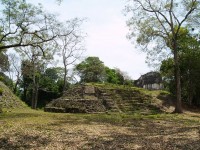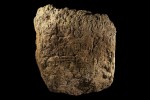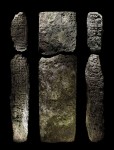 The ancient Maya city of Naachtun is in the jungle of northern Guatemala just over half a mile from the Mexican border. Founded around 400 B.C. in the Preclassic Period, it was one of very few important urban centers in the region to not only survive into the Classic Period, but thrive. At its peak between 500 and 800 A.D., the city had a population of 20,000 people, multiple pyramids, grand public buildings, more than 40 inscribed stele and a massive palace complex spread out over four hectares. The total size of the site is at least 200 hectares, 50 of which were occupied by monumental public structures.
The ancient Maya city of Naachtun is in the jungle of northern Guatemala just over half a mile from the Mexican border. Founded around 400 B.C. in the Preclassic Period, it was one of very few important urban centers in the region to not only survive into the Classic Period, but thrive. At its peak between 500 and 800 A.D., the city had a population of 20,000 people, multiple pyramids, grand public buildings, more than 40 inscribed stele and a massive palace complex spread out over four hectares. The total size of the site is at least 200 hectares, 50 of which were occupied by monumental public structures.
Its location between the great Maya rival powers of Tikal to the south and Calakmul to the north in modern-day Mexico gave the city great strategic importance. Whether they were fighting each other or trading with allied city-states, Tikal and Calakmul had to go through Naachtun, and the city profited ably. According to hieroglyphic inscriptions discovered at this site and others, Naachtun changed sides repeatedly during the Classic Period, an unusually flexible posture in a region that was highly polarized between the two main superpowers. That, along with its uniquely formidable defenses — walls 13 feet high made out of large limestone blocks — allowed Naachtun to prosper during centuries of war.
Its fortunes fell along with those of Tikal and Calakmul. The great regional powers began a precipitous decline in the late 8th century and Naachtun, which had flourished through the upheaval of the transition between the Preclassic and the Classic, declined with them. The city was abandoned around 800 A.D.
 It was rediscovered in 1922 by American archaeologist and pioneering Maya scholar Sylvanus Morley. Sponsored by the Carnegie Institution, Morley searched the Petén Basin north of Tikal for lost Maya cities. He enlisted the expertise of the chicleros, the men who collect sap from chicle trees, offering them a bounty for any ancient ruins they told him about. Chiclero Alfonso Ovando had stumbled on the Naachtun site in 1916. He told Morley about it and Morley explored the site, mapping many of its structures and discovering 19 stele.
It was rediscovered in 1922 by American archaeologist and pioneering Maya scholar Sylvanus Morley. Sponsored by the Carnegie Institution, Morley searched the Petén Basin north of Tikal for lost Maya cities. He enlisted the expertise of the chicleros, the men who collect sap from chicle trees, offering them a bounty for any ancient ruins they told him about. Chiclero Alfonso Ovando had stumbled on the Naachtun site in 1916. He told Morley about it and Morley explored the site, mapping many of its structures and discovering 19 stele.
It was Morley who named the site Naachtun, “far stone” in Mayan, because of how remote and inaccessible it was. That inaccessibility has made archaeological investigations of the site infrequent and of short duration. It wasn’t until the 1990s that the actual Mayan name of the city was identified on a stela as Masuul, and archaeologists are still working on deciphering the stele that Morley discovered nearly a century ago.
 Two of those stele have recently borne fruit. Newly deciphered hieroglyphics have revealed the name of the kingdom of which Masuul was the capital: the Suutz, meaning Bat in Mayan, kingdom. The Bat kingdom has been references in inscriptions found on other sites, including Tikal and Calakmul, but until now, archaeologists weren’t sure if it was a more of a regional designation with shifting capitals than a kingdom with a specific urban capital and ruling dynasty. The new text confirms that Masuul was the capital of the Bat kingdom and it was ruled by the Bat dynasty from the second half of the 4th century. (I love how much this sounds like a particularly awesome episode of the 1960s Batman TV series.)
Two of those stele have recently borne fruit. Newly deciphered hieroglyphics have revealed the name of the kingdom of which Masuul was the capital: the Suutz, meaning Bat in Mayan, kingdom. The Bat kingdom has been references in inscriptions found on other sites, including Tikal and Calakmul, but until now, archaeologists weren’t sure if it was a more of a regional designation with shifting capitals than a kingdom with a specific urban capital and ruling dynasty. The new text confirms that Masuul was the capital of the Bat kingdom and it was ruled by the Bat dynasty from the second half of the 4th century. (I love how much this sounds like a particularly awesome episode of the 1960s Batman TV series.)
 The hieroglyphic texts also place Masuul in the middle of the momentous events of January 16th, 378 A.D., when Tikal was defeated by forces from Teotihuacan. Teotihuacan, a powerful city-state 30 miles from modern-day Mexico City, is almost 800 miles northwest of Tikal, but that didn’t stop general Siyah K’ak’ (Fire Is Born) from killing Tikal’s king Chak Tok Ich’aak (Great Jaguar Paw), conquering the city and installing the six-year-old king Yax Nuun Ayin (First Crocodile), son of a figure known in descriptive non-native glyphs as Spearthrower Owl who was probably the ruler of Teotihuacan. First Crocodile married a daughter of the displaced Tikal ruling family and started a new dynasty. According to the newly deciphered stele, Masuul was an ally of Teotihuacan during this battle for Tikal.
The hieroglyphic texts also place Masuul in the middle of the momentous events of January 16th, 378 A.D., when Tikal was defeated by forces from Teotihuacan. Teotihuacan, a powerful city-state 30 miles from modern-day Mexico City, is almost 800 miles northwest of Tikal, but that didn’t stop general Siyah K’ak’ (Fire Is Born) from killing Tikal’s king Chak Tok Ich’aak (Great Jaguar Paw), conquering the city and installing the six-year-old king Yax Nuun Ayin (First Crocodile), son of a figure known in descriptive non-native glyphs as Spearthrower Owl who was probably the ruler of Teotihuacan. First Crocodile married a daughter of the displaced Tikal ruling family and started a new dynasty. According to the newly deciphered stele, Masuul was an ally of Teotihuacan during this battle for Tikal.
There’s a photo gallery here with the stele, some maps and some breakouts of the glyphs. The labels are in Spanish but you can at least make out the bat features.
EDIT: I originally identified Teotihuacan as modern-day Mexico City, confusing it with Tenochtitlan. Many thanks to Lon for the correction.
What wonderful names!
I can almost hear the music of their kingdom’s official anthem in my head.
Naachtun is one of those little-understood Maya sites that fascinates me. Located in a remote corner of the Peten at the end of a very primitive road it retains the feel of a lost-world jungle ruin. Furthermore many questions concerning Naachtun’s importance and history remain to be answered. My first attempt to reach Naachtun was thwarted after hours of hacking at fallen trees and negotiating numerous mudholes. Last year I finally succeeded and spent part of a day wandering among the fallen and partially intact structures. It is very much worth the effort to get there.